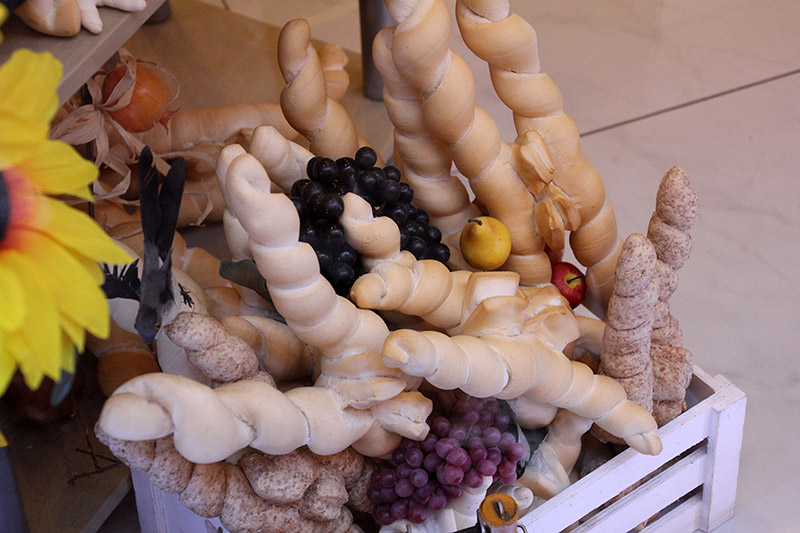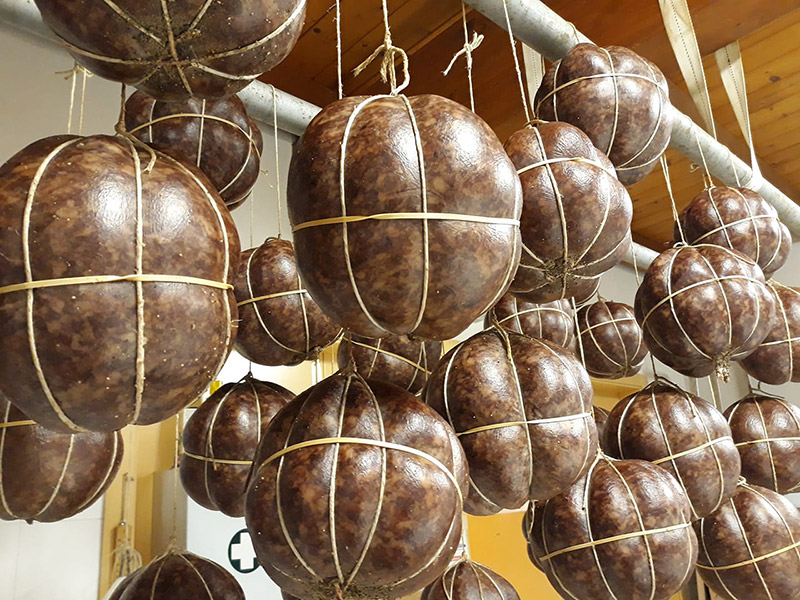SHARRYLAND


Ferrara's formidable salama da sugo
Smoldering on its soft bed of mashed potato, the 'salamina' is a sausage that mostly releases emotions

Where is

"Renowned specialty of pure Ferrara brand"-this is how it says in the historic Italian Touring Club Gastronomic Guide-"is salama da sugo, made of pork heavily drugged and sprinkled with old, alcoholic vin vecchio. It has the appearance of a small mortadella and is cooked by boiling. It is eaten hot, with a spoon, because when it is cooked it has a very soft consistency. Its flavor is spicy and gangly, and it is a truly distinctive food, which in Ferrara and outside has numerous and very loyal lovers." However much water has passed under the bridges of the Po, the reality of this delicacy has remained essentially the same. Only that from being an exquisitely winter dish, it has become a gastronomic attraction that knows no season, as much in the spoon version, proper to young salami, as in slices or wedges, later in the seasoning process. In the glass, as the guide itself suggests, a Fortana del Bosco Eliceo, now Doc, a red produced on the sandy soils of the early Adriatic hinterland.
The salamina, unmistakable
The 'salamina,' as the people of Ferrara affectionately call it, is an absolutely distinctive sausage. It is so in terms of mixture, pork from heterogeneous cuts (coppa, liver, tongue), ground rather finely and definitely spiced (pepper, cloves, cinnamon, nutmeg), but above all macerated in red wine. It is also so by container, not the usual casing, but a bladder, which gives it, once tied, a vaguely spherical shape. For cooking in boiling water, the salama should be wrapped in a white cloth and suspended from a wooden spoon placed across the pot so that it does not touch the metal. Thus, after at least four hours, the salama arrives intact on the cutting board and when opened reveals its succulent contents. A pragmatic side dish , mashed potatoes, but don't forget that the city of the Este family is famous for a bread that knows no equal, the coppia ferrarese: two rolled, pointed croissants that break away from a central knot; soft at the core, crispy at the ends, it is as ideal for succulent foods as it is for cheese and charcuterie snacks.
 Uncestino with the unmistakable Ferrara couple
Uncestino with the unmistakable Ferrara coupleFerrara and its surroundings
Of course, Ferrara is the capital of salama da sugo, but it is the Ferrarese that supports its fortunes in practice. In the sense that this specific charcuterie production has its strongholds in the province: small towns fierce in asserting primacy concerning it if not even primogeniture. Thus we learn of smaller localities that periodically rise to the glory of the provincial chronicles for charcuterie merits. There are, in fact, several festivals not to be missed to come into contact with the more frank reality of this cured meat. In mid-July, "La sagra della salama da sugo di Buonacompra," a locality that then returns to the subject again in mid-October with "I giorni della salama da sugo." And again, between late September and early October, the "Sagra della salamina da sugo al cucchiaio," held in Madonna Boschi, a locality of Poggio Renatico. Finally, we also point out the semi-serious "World Championship of Salama da sugo," which in the second half of February sees producers from the Ferrarese region converge in Migliarino di Fiscaglia.
Illustrious ancestors
Cristoforo di Messisbugo was a "master cook" at the court of Alfonso I d'Este at a time when this role also played a considerable role in diplomacy. In other words, a master of ceremonies, capable of organizing hundred-course banquets, punctuated by musical interludes and other amenities, during which the fate of the continent was discussed. Elevated to the rank of count palatine by Emperor Charles V, Messisbugo is considered one of the advocates of Ferrara's establishment among the great cities of the time. And like an ambassador who at some point feels he must commit his memoirs to history, he wrote a treatise ranging from the practice of cooking to the art of banqueting. Dwelling, as a good Ferrara native, on the art of preparing certain "mortadelle di ficato" using well-ground pork and liver for that matter, with salt, pepper and "vino vermiglio." Salumi of high lineage, then, from which modern, more democratic salame da sugo are descended.
 A collection of wonderful salame da sugo
A collection of wonderful salame da sugoA literary salami
In 1772 the highly esteemed Ferrara magistrate Antonio Frizzi, as sometimes happens to those who must be morose by institutional duty, wrote a facetious little poem, "the fruit of youthful recreations," on the merits of the pig, "La salameide," in which he dedicates moving stanzas to salama da sugo: "A juicy salami "-this is how he begins- "uses to form my Ferrara not elsewhere used," then describing its contents by grain and color as a "soft porphyry." A curious oxymoron, because red porphyry is one of the stones most sought after by the ancients to carve columns of temples and royal sarcophagi from it, but in this salumeria meaning the poet imagines it soft and dripping with a "purple liquor." And what goodness, to put even "Maecenas, Heliogabalus, and LucuIIo," the triad of classical gastronomy, to shame.
Enter the Map of Italy's Undiscovered Wonders and find treasures where you least expect it... Inspire, Recommend, Share...
The Map thanks:
Enter the Map of Italy's Undiscovered Wonders and find treasures where you least expect it... Inspire, Recommend, Share...
Where is


